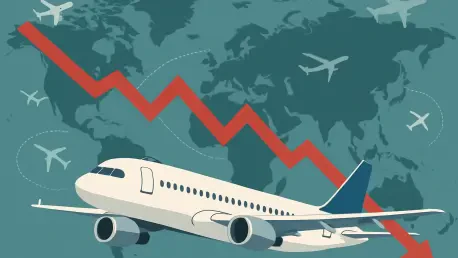Imagine a world where the skies, once buzzing with unprecedented post-pandemic recovery, begin to show signs of strain as growth in passenger numbers slows. In June, the global air travel market encountered a notable deceleration, with demand growth dropping to a modest 2.6% year-on-year, signaling a critical juncture for airlines, investors, and policymakers who must navigate an evolving landscape of capacity challenges and regional disparities. The importance of understanding these trends cannot be overstated, as air travel remains a cornerstone of global connectivity and economic vitality.
This market analysis aims to dissect the underlying factors driving the slowdown, providing stakeholders with actionable insights into current patterns and future implications. It examines the delicate balance between demand and capacity, which has grown at a faster pace of 3.4%, leading to a slight dip in efficiency metrics. By delving into regional variations and broader economic influences, the discussion seeks to illuminate the path forward for an industry at a pivotal moment.
The significance of this analysis lies in its ability to inform strategic decisions amid uncertainty. With load factors hovering near historic highs at 84.5%, yet showing a marginal decline, the aviation sector faces questions about sustainability and profitability. This exploration offers a comprehensive view of where the market stands today and what forces might shape its trajectory in the coming months.
Deep Dive into Market Dynamics
Current Trends: Decoding the Slowdown in Demand
The air travel market in June revealed a marked slowdown in demand growth, with a year-on-year increase of just 2.6% as measured in revenue passenger kilometers. This figure represents a significant departure from the robust growth rates observed in prior periods, reflecting a combination of economic headwinds and geopolitical disruptions. Factors such as military conflicts in key regions have notably dampened passenger confidence, impacting the overall momentum of the sector’s recovery.
Capacity expansion, meanwhile, has outstripped demand, rising by 3.4% in available seat kilometers. This imbalance has led to a slight decline in the global load factor by 0.6 percentage points to 84.5%, indicating that while flights remain relatively full, airlines are struggling to fill the additional seats added to their networks. Such a trend raises concerns about operational efficiency and profitability, particularly for carriers that have invested heavily in scaling up operations.
The disparity between demand and capacity growth underscores a broader challenge for the industry: aligning expansion strategies with actual passenger uptake. As airlines grapple with this issue, the risk of overcapacity looms large, potentially squeezing margins in an already competitive market. This dynamic sets the stage for a closer examination of how different regions are faring amid these global trends.
Regional Breakdown: Diverse Performance Across Markets
A detailed look at regional data highlights stark contrasts in market performance, painting a picture of an uneven recovery. Asia-Pacific carriers stand out with a strong 7.2% year-on-year demand increase, driven by vibrant economic activity and a growing appetite for travel. However, a 7.5% surge in capacity slightly eroded efficiency, resulting in a load factor drop to 82.9%, suggesting room for optimization in this high-growth area.
Latin American airlines also reported impressive gains, with demand soaring by 9.3%. Yet, an aggressive capacity increase of 11.8% led to a more pronounced load factor decline to 83.3%, reflecting the challenges of balancing growth with utilization rates. In sharp contrast, the Middle East market faced a demand contraction of 0.4%, largely due to ongoing conflicts disrupting critical routes, with capacity growth of 1.1% further dragging the load factor down to a regional low of 78.7%.
Domestic markets, accounting for a significant portion of global traffic, present a mixed outlook. Brazil’s domestic demand surged by an impressive 14.7%, though a 17.0% capacity expansion caused a load factor drop to 83.0%. The United States, the largest domestic market, saw negligible growth at 0.1%, with capacity up by 1.8%, leading to a load factor decline to 86.0%. These regional disparities highlight the need for tailored strategies to address unique market conditions and external pressures.
External Influences: Geopolitical and Economic Factors
Beyond raw numbers, the air travel market is heavily influenced by external forces that shape passenger behavior and airline operations. Geopolitical instability, particularly in the Middle East, has directly impacted demand on key international routes, with declines of 7.0% to North America and 4.4% to Europe. Such disruptions serve as a reminder of the industry’s vulnerability to events outside its control, necessitating agile responses from carriers.
Economic factors, including fluctuating fuel costs and persistent inflation, further complicate the landscape. These pressures not only elevate operating expenses for airlines but also affect ticket affordability, potentially curbing demand among price-sensitive travelers. In regions like North America and Africa, where demand dipped by 0.3% each, economic constraints may be contributing to a shift in consumer priorities away from discretionary travel.
The interplay of these external elements suggests that airlines must adopt flexible approaches to mitigate risks. Adjusting route networks to focus on more stable or high-growth markets could offer a buffer against volatility. Additionally, leveraging data analytics to anticipate demand fluctuations in real time may prove critical in maintaining a competitive edge amid such uncertainties.
Future Projections: Navigating the Path Ahead
Looking toward the near term, industry projections indicate a potential moderation in capacity growth, with schedules for August showing a more restrained increase of 1.8%. This adjustment could help stabilize load factors, particularly during the peak summer travel season in the Northern Hemisphere, offering airlines an opportunity to better align supply with demand. Such a shift may alleviate some of the pressure on efficiency metrics observed in June.
Technological innovations are also expected to influence market dynamics over the next few years. The adoption of sustainable aviation fuels and more efficient aircraft designs could address cost challenges while meeting growing regulatory demands for reduced carbon emissions. These advancements, if scaled effectively, might provide a dual benefit of lowering operational expenses and enhancing the industry’s environmental footprint.
Speculative trends point to evolving travel patterns that could reshape demand. The persistence of hybrid work arrangements may continue to suppress business travel, while leisure travel could remain a growth driver as consumers prioritize experiences. Airlines will need to stay adaptable, balancing short-term capacity tweaks with long-term investments in sustainability and customer-focused solutions to remain resilient in a shifting market.
Reflecting on Insights and Charting Next Steps
Looking back, the market analysis for June revealed a global air travel industry grappling with a slowdown in demand growth to 2.6%, while capacity expansion at 3.4% led to a marginal load factor decline to 84.5%. Regional variations underscored the uneven nature of recovery, with strong performances in Asia-Pacific and Latin America contrasted by struggles in the Middle East due to geopolitical tensions. The examination of external influences and future projections highlighted the complexity of sustaining growth amid economic and operational challenges.
For airlines, the next steps involve prioritizing data-driven capacity planning to avoid overextension, particularly in underperforming regions. Exploring diversification into high-potential markets like Asia-Pacific could offer a strategic advantage. Policymakers, on the other hand, should focus on fostering stability in conflict-affected areas and supporting sustainable aviation initiatives to bolster long-term industry health.
Travelers and businesses also have a role to play, with opportunities to optimize travel plans around off-peak periods or emerging destinations for cost savings. Monitoring regional trends could inform better decision-making for corporate travel policies. Collectively, these actions provide a roadmap for stakeholders to address the immediate slowdown while building resilience for future uncertainties in the air travel market.









